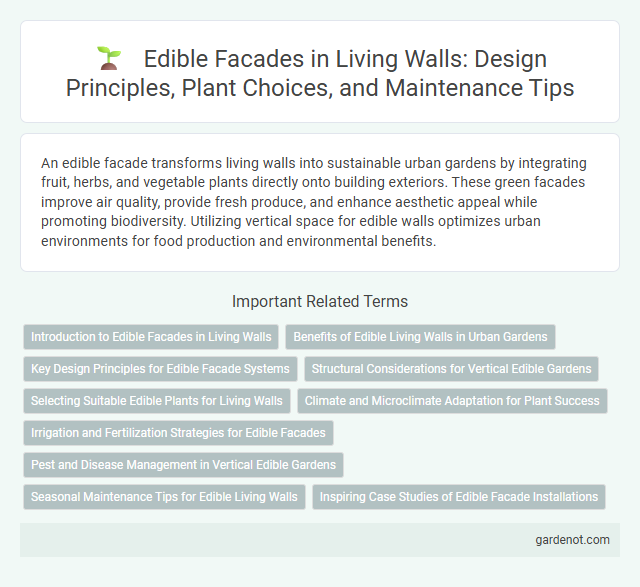An edible facade transforms living walls into sustainable urban gardens by integrating fruit, herbs, and vegetable plants directly onto building exteriors. These green facades improve air quality, provide fresh produce, and enhance aesthetic appeal while promoting biodiversity. Utilizing vertical space for edible walls optimizes urban environments for food production and environmental benefits.
Introduction to Edible Facades in Living Walls
Living walls with edible facades integrate vertical gardening techniques to cultivate fruits, vegetables, and herbs on building surfaces, enhancing urban food production. These edible facades improve air quality, reduce heat absorption, and promote biodiversity while providing fresh, locally grown produce. Implementation involves selecting compatible plant species, efficient irrigation systems, and sustainable structural materials to support plant growth and facade longevity.
Benefits of Edible Living Walls in Urban Gardens
Edible living walls enhance urban gardens by maximizing green space and promoting sustainable food production within limited areas. They improve air quality and urban biodiversity, creating healthier environments while reducing food miles through local cultivation of herbs, vegetables, and fruits. These facades also provide insulation, lowering energy costs and contributing to urban heat island mitigation.
Key Design Principles for Edible Facade Systems
Key design principles for edible facade systems emphasize plant selection based on local climate adaptability and growth habits to ensure sustainable productivity. Structural support must accommodate weight and root expansion while allowing efficient irrigation and drainage systems to maintain plant health. Integration of biodiversity with edible and pollinator-friendly species enhances ecosystem services and urban resilience.
Structural Considerations for Vertical Edible Gardens
Structural considerations for vertical edible gardens include selecting durable materials such as galvanized steel frames and weather-resistant substrates to support plant weight and moisture retention. Proper load distribution and secure anchoring systems are essential to withstand wind pressure and prevent structural damage. Integrating efficient irrigation and drainage systems helps maintain plant health while protecting the building facade from water infiltration.
Selecting Suitable Edible Plants for Living Walls
Selecting suitable edible plants for living walls involves choosing species that thrive in vertical environments with limited soil and water. Herbs like basil, thyme, and mint, as well as leafy greens such as lettuce and kale, are ideal due to their shallow root systems and manageable growth habits. Incorporating drought-tolerant plants like strawberries and cherry tomatoes enhances productivity while ensuring sustainability in urban edible facades.
Climate and Microclimate Adaptation for Plant Success
Edible facades contribute to climate and microclimate adaptation by regulating temperature and humidity around buildings, creating favorable conditions for plant growth. These living walls enhance urban biodiversity, improve air quality, and provide natural insulation that reduces energy consumption. By fostering microclimates supportive of diverse edible plants, they ensure higher yields and long-term sustainability in urban agriculture.
Irrigation and Fertilization Strategies for Edible Facades
Efficient irrigation systems for edible facades often utilize drip irrigation combined with rainwater harvesting to ensure consistent moisture without water wastage. Fertilization strategies prioritize slow-release organic fertilizers and liquid nutrient delivery through irrigation to support continuous plant growth and soil health. Monitoring soil moisture and nutrient levels with sensors optimizes resource use and promotes sustainable edible wall maintenance.
Pest and Disease Management in Vertical Edible Gardens
Effective pest and disease management in vertical edible gardens requires integrated strategies that prioritize plant health and minimize chemical use. Regular monitoring, the use of beneficial insects like ladybugs, and organic treatments such as neem oil promote natural pest control while safeguarding edible plants. Proper airflow, hygiene practices, and resistant plant varieties also reduce disease incidence, ensuring a thriving living wall harvest.
Seasonal Maintenance Tips for Edible Living Walls
Edible living walls require seasonal maintenance to optimize growth and yield, including pruning spent plants in late fall to prepare for dormancy and prevent pest infestations. Regular soil testing and amendment with organic compost during spring boost nutrient availability, ensuring healthy development of herbs, vegetables, and fruits. Winter protection through mulching and frost covers minimizes damage to sensitive plants, extending the productive life of the edible facade.
Inspiring Case Studies of Edible Facade Installations
Edible facade installations, such as the Bosco Verticale in Milan and the Eden Project in the UK, showcase innovative approaches to urban agriculture by integrating fruit, herbs, and vegetable plants into building exteriors. These projects enhance biodiversity, improve air quality, and promote sustainable food sources within dense urban environments. Their success inspired numerous cities to adopt edible facades as a multifunctional solution for green infrastructure and food resilience.
Edible facade Infographic

 gardenot.com
gardenot.com